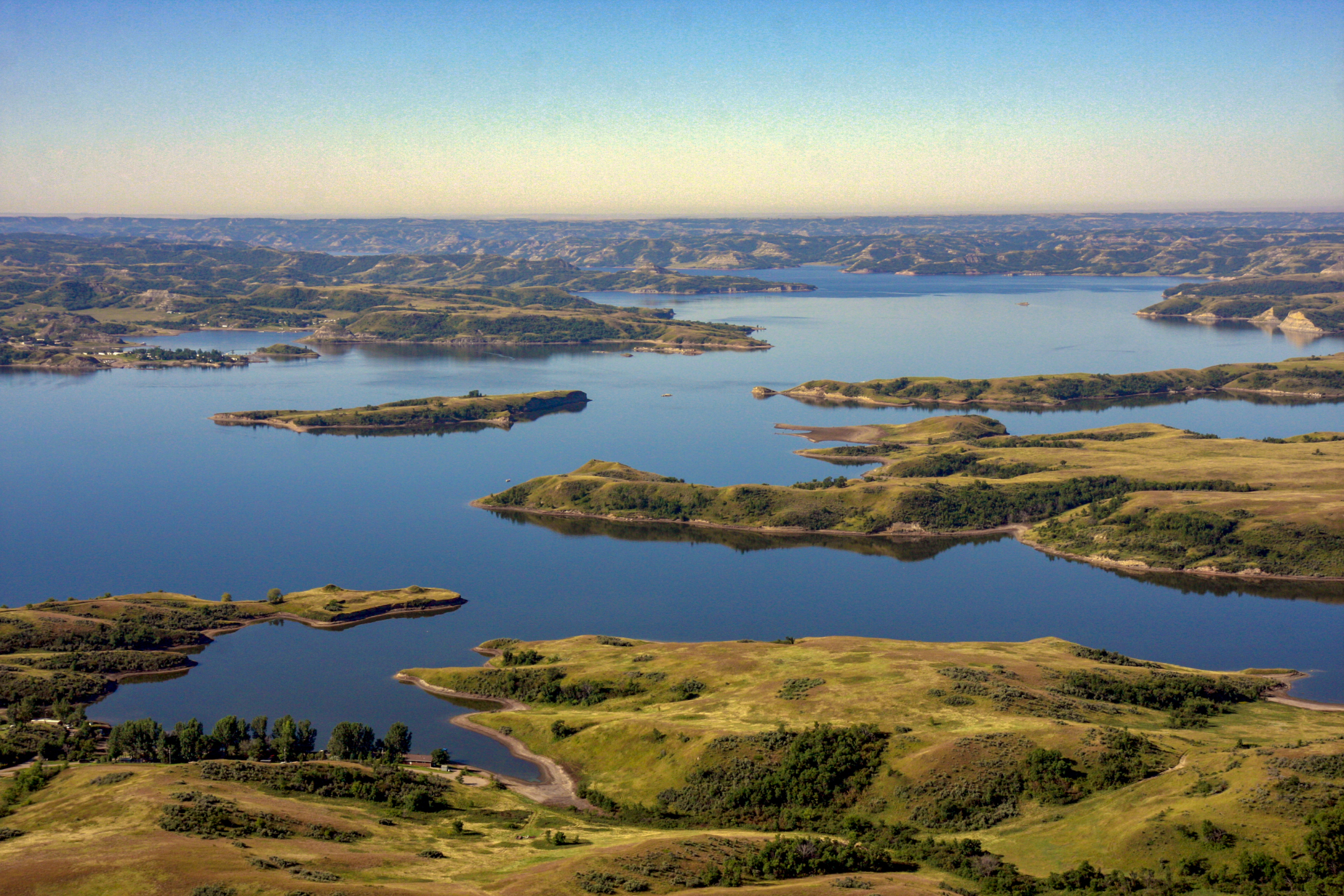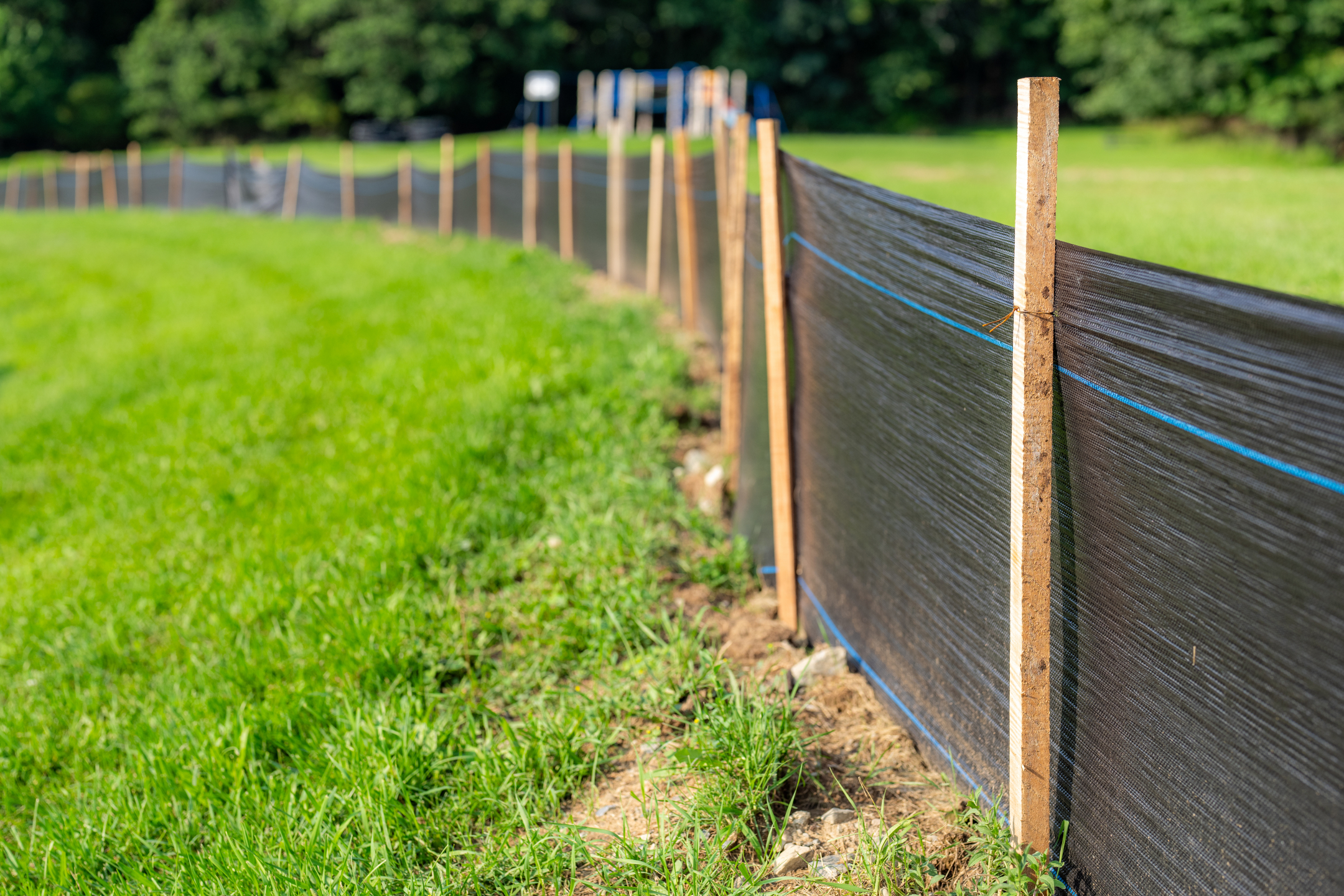Managing Stormwater in North Dakota
Statewide, the North Dakota Department of Transportation (NDDOT) operates and maintains highways, rest areas, maintenance areas and a number of other impervious surfaces. Impervious surfaces--including driveways, sidewalks and streets--prevent precipitation from rain or snowmelt from naturally soaking into the ground.
As stormwater runs off impervious surfaces and nearby properties, it can pick up pollutants like oil, fertilizers, pesticides, dirt, trash, animal waste and other debris. These pollutants (called "non-point source pollutants") then flow into a storm sewer system or directly to a lake, stream, river, wetland or other aquatic resource and can degrade the quality of North Dakota's water resources.
If left uncontrolled and untreated, stormwater runoff can harm habitats, erode stream channels and carry pollutants into lakes, rivers, wetlands and the bodies of water we use for swimming, fishing and providing drinking water.

Preventing Stormwater Pollution
Below you will find information about efforts to combat issues related to stormwater runoff.
As authorized by the Clean Water Act, the National Pollutant Discharge Elimination System (NPDES) permit program controls water pollution by regulating point sources that discharge pollutants into waters of the United States. Point sources are discrete conveyances such as pipes or man-made ditches.
Individual homes that are connected to a municipal system, use a septic system or do not have a surface discharge do not need an NPDES permit; however, industrial, municipal, and other facilities must obtain permits if their discharges go directly to surface waters. In most cases, the NPDES permit program is administered by authorized states. In North Dakota, the NPDES program is administered by the North Dakota Department of Environmental Quality (NDDEQ).
Polluted stormwater runoff is commonly transported through Municipal Separate Storm Sewer Systems (MS4s), from which it is often discharged untreated into local bodies of water. An MS4 is a conveyance or system of conveyances that is:
- Owned by a state, city, town, village or other public entity that discharges to waters of the US;
- Designed or used to collect or convey stormwater (including storm drains, pipes, ditches, etc.);
- Not a combined sewer; and
- Not part of a Publicly Owned Treatment Works (sewage treatment plant).
To prevent harmful pollutants from being washed or dumped into an MS4, operators must obtain a NPDES permit and develop a stormwater management program.
A new Memorandum of Understanding (MOU) has been developed and signed by the North Dakota Department of Transportation (NDDOT) and the North Dakota Department of Environmental Quality (NDDEQ). This agreement is entered into by each agency to promote interagency cooperation and to define the duties of each agency as they relate to the efficient implementation of erosion and sediment control on highway construction projects in North Dakota. Changes have been made to the previous MOU and are as follows:
- A project area that would require a permit has been given a more clear definition.
- Added language explaining that work on projects that do not require a permit must be performed in a manner that does not affect water quality.
- Added language requiring contractors to obtain separate permits for any contractor-controlled areas.
- Added the requirements of the EPA Consent Agreement signed by the NDDOT on June 12, 2012. These requirements are detailed in Section E of the Agreement.
- Added language to better define an erosion control failure.
- Detailed that only the NDDOT, not the contractor, can file a Notice of Termination with the NDDEQ to terminate a permit.
- Removed outdated processes that are no longer used by the NDDOT.
Training and Education
- 2023-2024 Erosion and Sediment Control Certification Program Notice
- Erosion and Sediment Control Certification Training and Resources
- Stormwater Poster
- Stormwater Brochure
- Other Certification and Training Opportunities for Contractors and Consultants
Links
- NDDOT Standard Specifications for Road and Bridge Construction
- NDPDES Construction Site Inspection Template
- Stormwater Manuals and Publications - For reference purpose only. Items may need to be revised to NDDOT Standards and Specifications, NDDOT Standard Drawings and the NDPDES Construction Permit.

Resources
- NDDEQ Stormwater Program
- NDDEQ Construction General Permit Page
- Agreement of Understanding between NDDOT and NDDEQ
- NDDEQ Construction General Permit
- NDDEQ Customizable SWPPP Template
- NDDEQ Integrated Reports Page
- 303 (d) listed waters
- NDDEQ Total Maximum Daily Load Page Information
- NDDEQ Municipal Separate Storm Sewer System (MS4) Page
- NDDEQ (MS4) Permit
- NDDEQ Stormwater Field Inspection Report
- EPA Water
- National Pollutant Discharge Elimination System (NPDES)
- EPA 2022 Construction General Permit (CGP) Page
- EPA Construction General Permit Resources, Tools and Templates
- Tools and Maps
- SWPPP Templates
- Determine 2-Year, 24-Hour Storm Even for Sediment Basin Design
- Inspection and Corrective Action Report Templates and Other Guidance
- Monitoring and Inspection Guide for Construction Dewatering
- Professional Resources
- EPA - CGP Turbidity Benchmark Monitoring (Dewatering)
- EPA - CGP Inspector Training
- Stormwater Discharges from Transportation Sources
- EPA Electronic Construction General Permit Notice of Intent (eNOI) Page
- EPA Expedited Settlement Agreement Form for Construction
Stormwater Retention FAQs
There are two permits that might be applicable to a land disturbance site. Both are only applicable for sites larger than one acre. If the site is greater than an acre in size and on Tribal Land, the Environmental Protection Agency (EPA) Construction General Permit is applicable. If the site is greater than an acre and on any land other than Tribal Land, the North Dakota Department of Health (NDDoH) Construction General Permit is applicable. Please be aware that if your site contains land on both Tribal and Non-Tribal Lands, both permits are applicable and must be obtained before any work is done.
No. With the Project Engineer’s approval, other BMPs can be substituted if needed. Please be aware that any change in BMP will require an update to the SWPPP.
Yes. Erosion and sediment controls may need to be changed depending upon site conditions and weather conditions. If something in the plans or the SWPPP is not working, a change should be made. Please be aware that any change in BMP will require an update to the SWPPP.
No. A SWPPP is only required when a permit is required. A SWPPP is recommended on all sites to help ensure compliance with the Clean Water Act.
All appropriate action must be taken to meet the requirements of the applicable permit. If that means frequent mobilizations for erosion and sediment control, then that must be done.
No. Sensitive areas such as wetlands are sometimes located inside the right of way and must be protected. Also, it is much easier to prevent erosion than it is to remove sediment from water. Installing and maintaining erosion controls on disturbed areas as soon as possible is key in preventing erosion.
The contractor is considered the operator of the site and as such is responsible for the day to day activities on the site, such as updating the SWPPP, conducting inspections and maintaining BMPs. The North Dakota Department of Transportation (NDDOT) is considered the owner of the permit and is responsible for making sure the operator is complying with the permit. If violations are found, the owner and the operator are jointly responsible.
Depending upon which permit is applicable, either the NDDoH or the (EPA), or both, may inspect a site. The NDDoH can only inspect sites that are permitted by the NDDoH. The EPA can inspect sites permitted by the EPA or the NDDoH. If the EPA does an inspection on an NDDoH permitted site, it will inspect the site for compliance with the NDDoH permit.
If the area is covered by NDDOT’s Construction Permit, it, as the owner of the permit, has a right to require installation and maintenance of erosion and sediment controls. NDDOT’s construction easement gives it the right to do this and it has a responsibility to meet the requirements of its permit. At the end of a project, if a private land owner does not wish to have NDDOT install permanent erosion and sediment controls on an active site on his or her land, then NDDOT should modify its SWPPP to not include that area in its project and inform the land owner of his or her responsibility to obtain his or her own permit for that area.
An inspector will ask to look at all the documentation required by the permit (Storm Water Pollution Prevention Plan (SWPPP), copy of the permit, inspection logs, maintenance records, SWPPP changes, Site Map, etc.). They will also want to view the entire site to see if the Best Management Practices (BMPs) are installed as they are listed in the SWPPP and to ensure no sediment has been allowed to leave the site.
The NDDOT becomes the sole permittee for any active permit where it has released the contractor until the permit is terminated or a new contractor is placed under contract.
An acceptable BMP is one that controls erosion or sediment without causing secondary pollution such as water contamination, etc.
An acceptable SWPPP meets all the requirements of the applicable permit. The contractor should have a working copy of the SWPPP on the site at all times, making sure it reflects the exact conditions of the site at the time. A SWPPP can be a very lengthy document. If the SWPPP is relatively small (just a few pages), it more than likely is not adequate.
All areas that were disturbed during the course of the project must be stabilized with either impervious surfaces or perennial vegetation. If perennial (having a life cycle lasting more than two years) vegetation is used, it must cover 100% of the disturbed area with a density of 70%. These numbers are of pre-existing vegetation, so if the area was not completely vegetated before, it does not have to be completely vegetated to terminate the permit.
Through the MOA with the NDDoH, the NDDOT is allowed to install enough permanent BMPs and seed to provide this level of vegetation within three years and have a permit terminated. This only applies to the NDDoH permit.
Erosion controls are used to prevent soil from dislodging while sediment controls are used to remove sediment from water.
Temporary BMPs are installed at the beginning or during a project and are generally removed to make room for permanent controls. Permanent controls are installed on areas that have completed earth work, are not removed, and are installed so they require little to no maintenance.
The MOA is a Memorandum of Agreement between the NDDOT and the NDDoH that lays out the responsibilities of the NDDOT and its contractors in regards to Construction Permits.
The SWPPP, inspection logs, copy of the Notice of Intent, copy of the coverage letter (if applicable), maintenance records, Spill Prevention Control and Countermeasure plan (if applicable), and a copy of the permit. Please see the current applicable permit for a more updated list.
For the NDDoH permit, all areas within 200 lineal feet of surface water and with a continuous positive slope must be stabilized within 21 days of temporarily or permanently ceasing earth moving operations. For the EPA permit, if you are going to cease work in an area for more than 14 days, temporary stabilization must be initiated within 24 hours and completed before the end of the 14 days.
The SWPPP should be updated whenever there is a change onsite in design, construction, operations, or maintenance of any BMP or anything that will affect the BMPs. If in doubt, update!
According to the Spec Book, the contractor is required to conduct all inspections required by the applicable permit. The NDDOT is responsible for ensuring the contractor is conducting these inspections.


